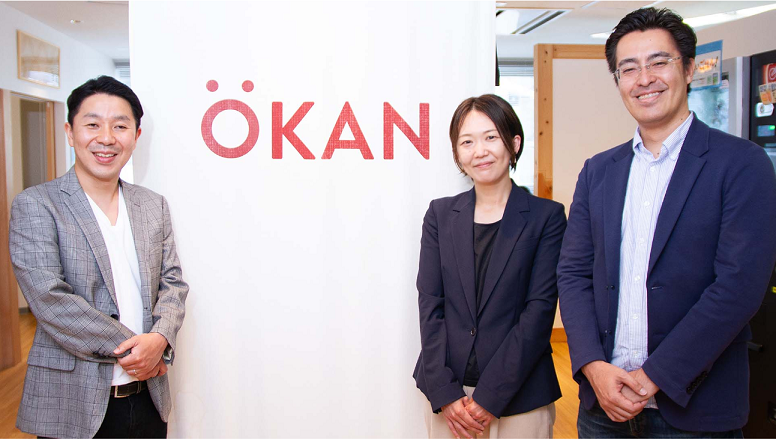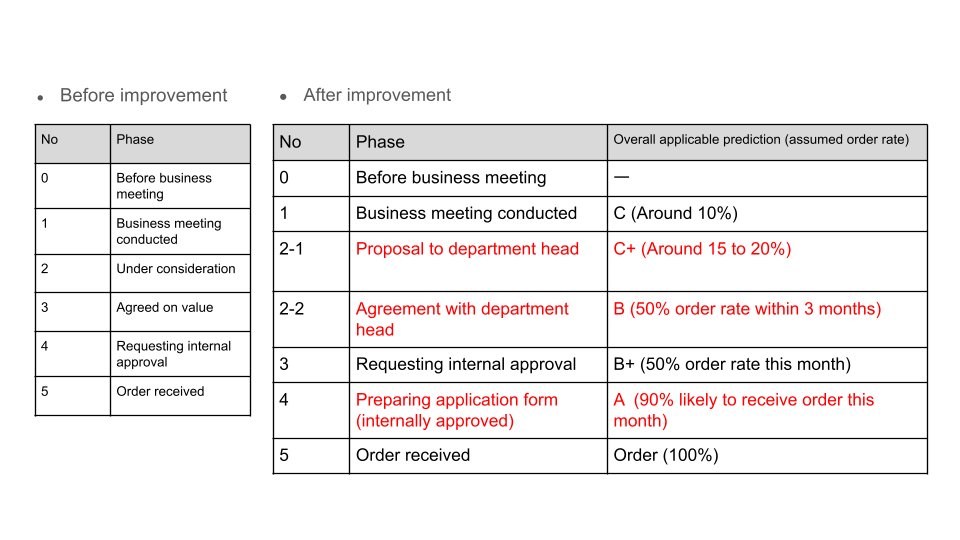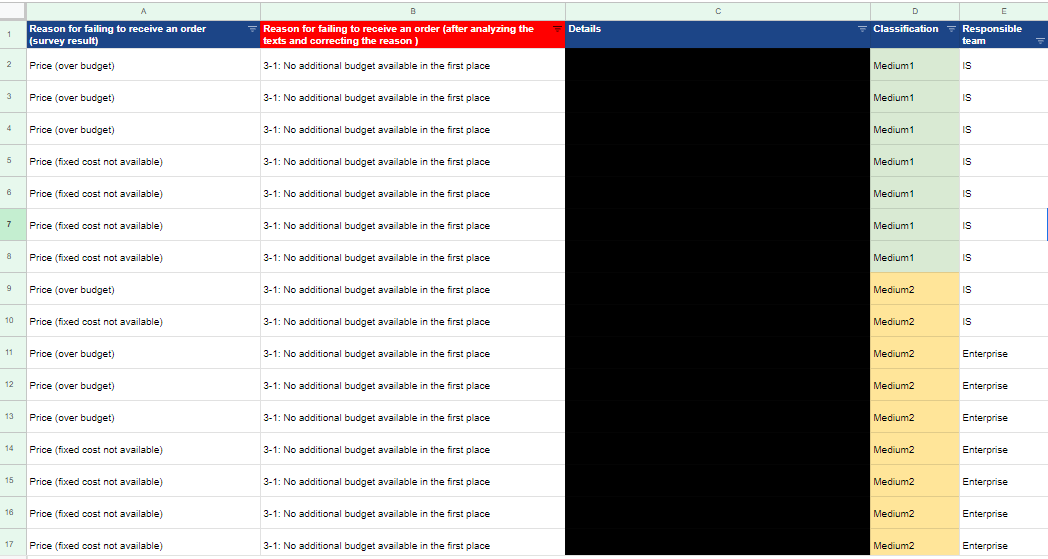How OKAN’s “Enterprise Sales” Achieved a Fivefold Increase
In-depth analyses and improvement in the team's hypothesis testing capabilities were the key to its successful enterprise sales.

Written by the Universe editorial team
One of the challenges often faced by B2B startups is “enterprise sales.” Enterprises are more likely to become large customers, and closing contracts with these companies would be a top priority to increase product credibility. However, they are also said to be a challenging customer group because of the long lead time and frequent personnel transfer.
OKAN, a company that mainly operates "Office Okan,” a company cafeteria service that delivers a selection of prepared food to offices, was also experiencing difficulties with its enterprise sales. The company decided to work with Global Brain (GB)’s support team to improve the situation. As a result, the company’s sales figures* grew fivefold in nine months. Behind this success was in-depth analyses and improvement in the team’s hypothesis testing capabilities.
We sat down with Yusuke Sasaki, Director and COO, Yuka Yasuba, enterprise sales manager, and Takuji Chida, a member of the GB Value Up Team who supported them to talk about their efforts. (Questions in bold letters were asked by the Universe editorial team).
*New MRR (Monthly Recurring Revenue) and new MRR per sales representative
Typical Sales Model Did Not Work
OKAN has succeeded in improving enterprise sales, but we heard that you used to struggle. How was the situation back then?
Yasuba: To begin with, OKAN’s enterprise team also targets what is generally called “middle” customers. So, the team is handling companies with the number of employees ranging from 100 to tens of thousands.
While the team is serving various customers, we had only two or three members before GB’s Chida-san started to support us. At that time, we depended on their individual skills, which resulted in the sales data being hardly managed, analyzed, or standardized. For enterprise customers, we adopted the model sales approach that had been successful in SMB (small and medium-sized businesses) sales, which unfortunately did not easily bear fruit.

Sasaki: Although “Office Okan” is not exactly a service for SMBs, many SMB customers have used our service since we started the company. As we were always struggling to expand business with larger companies, we now know that the way of communicating with enterprise customers is different from that with SMB customers.
For example, while it is easy to estimate ROI for SMB sales due to shorter lead time, enterprise customers have longer lead time, and their ROI is difficult to estimate. With these differences, it was long difficult for us to figure out an effective sales approach to enterprise customers.
Yasuba: I knew that I had to work on data analysis and structure building to address this, so I had been collecting sales data but not analyzing it enough to thoroughly design the sales activities. I wanted to work on those matters properly, but I did not have a good knowledge of data analysis. So, people started to call me "Duke Hyou.”
Duke Hyou?
Yasuba: He is a character in the Japanese manga series “Kingdom.” I know little about it, but he seems to be a person of instinct who charges forward with all his might [laughs].
However, the situation changed for the better because more enterprise sales team members were going to join and Chida-san’s support started just when I became manager. I was finally able to get things going.
Redefining Sales Phases and Order Predictions, and “Visualizing” Business Negotiations
Since then, you have started to improve the situation. What kind of measures did you take?
Chida: First of all, I had the opportunity to sit in on a business meeting with OKAN sales members prior to starting the support. They had strong sales skills, and I felt there was no need to explain how to do the sales talk or what to propose.
After that, as I talked with Yasuba-san and others, I found two things that we should work on. The first thing was to improve the accuracy of their sales forecast and the likelihood of receiving orders compared with the target. Specifically, we refined sales phases and predictions through clarifying how many more business negotiations should be conducted, the necessary level of order rate, etc. at present compared with the monthly target. These actions are not special to clarify the actions that will lead to achieving goals. However, I feel that only a few companies are properly carrying out such actions.

Yasuba: Definitions of sales phases and predictions had been in place, but they were set without being fully considered. Also, we had been using the same definitions for a long time, so once again we visualized the business negotiations in detail.
Chida: We added the phases of “proposal to department head” and “agreement with department head” between “business meeting conducted” and “requesting internal approval.” We originally had the phases including “business meeting conducted,” “under consideration,” “agreement on value," “requesting internal approval,” and “order received.”
When negotiating with enterprises, the person you negotiate with often does not have the authority to request internal approval, so even if we agree on the value of introducing our services, it often does not lead to an order. For this reason, we have redesigned the process to be able to watch whether the customer has proposed or agreed with the department head and added “preparing application form (internally approved)” before “order received” so that the customer’s internal approval status can also be tracked.

The key to designing sales phases is to define them in terms of the customer’s actions, instead of OKAN’s actions. It is also important to define the phases by selecting actions that will lead to higher order rates when those actions are taken by the customer.
When we analyzed the correlation between the phases of OKAN’s business negotiations and predictions, we found that if the phase moves on to “agreement with department head,” the prediction will rise at once from C to B (50% order rate within 3 months). Each sales member began to focus their sales actions on “setting up opportunities to meet with division heads,” and as a result, we were able to improve the order rate in a short period of time.
Note that these sales phases may not apply to all B2B companies, as the customer actions that are highly correlated with orders vary depending on the services provided. Phases should be designed while figuring out the factors that influence the orders for your company’s service.
Analyzing Each of the 200 Lost Opportunities
How about the other measure?
Yasuba: The other measure is the discount campaign. While we were improving sales performance by increasing the accuracy of sales phases and predictions, we faced a situation where the goal cannot be achieved even if we continue the same measure. No matter how many times we calculated the numbers, the results always showed that the order rate must be doubled to achieve the goal.
Chida: It is obviously impossible to suddenly double the abilities of sales personnel, so we concluded that we needed to take a special measure and we focused our efforts into our discount campaign. As a result, the order rate doubled and sales soared two to three times.
Yasuba: Actually, we had other ideas, but the reason we decided to conduct the discount campaign was because of the “lost opportunity analysis” carried out by Chida-san. He carefully looked at each reason that our sales personnel had entered on Salesforce.
Chida: I looked at about 200 business meeting records of lost opportunities and categorized the reasons. On Salesforce, you can attach a tag to the reason for a lost opportunity (such as “reason: budget cannot be secured”), but when I carefully read the texts attached to the tags, I noticed that they were sometimes different from the content of the tags. For example, one opportunity was actually lost not because of budgetary constraints but because of the expensive pricing.
While looking at such details, we examined how many customers would respond to the discount campaign and what level of discount rate would result in positive sales results.

Yasuba: With this analysis, we were able to have a clear idea of the campaign benefits and immediately start incorporating the campaign into the annual sales schedule and coordinating with relevant departments.
Undoubtedly, OKAN’s extensive data made it possible to launch the campaign.
Chida: Yes, OKAN’s sales personnel had thoroughly entered the data, which was very helpful. I was also grateful that they shared all the data with me. OKAN already had the ideas of elaborating sales phases and launching campaigns. We just analyzed them and “agreed” that it would be a good idea (to get things going).
Yasuba: We did not think we were “forced" to take those measures. We did not feel like we received proposals out of the blue. We discussed with Chida-san, saying, “We seem to have issues here, and we think this measure will work,” and he took care of the groundwork.
Basically, he undertook everything we proposed, saying, "I see, I think that’s a very good idea. He then says, “I’ll look into this, this, and this on my own,” and promptly brings data and information that would support the measure. Since we had not been able to do such analyses, we relied on him a lot.
Chida: That brings back memories. I remember we repeated that process over and over.
PDCA Concept Permeated the Entire Team
So, you established a flow of taking measures based on hypotheses and verifying them. Have you noticed any changes within the company ever since? For example, is it now easier for Yasuba-san to discuss the measures with Sasaki-san using data?
Yasuba: That’s exactly true.
Sasaki: I feel that the quality of proposals from her has dramatically improved. The likelihood of me saying, “go ahead with it” has increased, and It is much easier now for me to communicate with her now [laughs].
Yasuba: Indeed [laughs].
Sasaki: Originally, our thought processes were completely the opposite, like Yasuba is a right-brained person and I am left-brained. By filling the gap between us, Chida-san made it easier for me to understand the measures and for Yasuba to explain them to me. As she mentioned earlier the “Kingdom” example, I think that Chida-san “translated” her instincts for me.

Are there any other areas that you see changes, Yasuba-san?
Yasuba: We are now able to properly follow the PDCA cycle, which is, identifying the gaps against the goal, actions to take, and results. Before, we only had results. We would try something and get a result, and then try something else that came to mind and get another result. We were not able to even predict the sales four months ahead.
But now we can say, “We have two/three months to go to achieve the target, so this amount of sales at this point in time should be good enough.” This means we are now able to strategically deal with sales forecasts and performance.
Chida: The sales team now reviews its performance once a month, and they are effectively following the PDCA cycle. Led by Yasuba-san, team members analyze the situation by reviewing the hypothesis, actual situation, and its cause.
Yasuba: Chida-san would ask us about our thought process, and this inspired us a lot. Since he also shared his thought process with us, the team including me were able to form a structure and make it a practice to speedily test our hypothesis.
I am sure OKAN’s sales team will become even more powerful following this achievement. Finally, would you mind telling us the team’s future goals and prospects, if any?
Sasaki: Yasuba mentioned earlier that the team has become more strategic, and I totally agree with her. I hope, in the future, even without Chida-san’s support, we will be able to develop a structure for Yasuba to better understand the team’s situation, which I am sure will lead to consistent performance and a stable team.
Yasuba: To build a stronger team, what we need first and foremost is for each member to become stronger as sales representatives. So, what I am committed to do is enhance the capabilities of each member. The scope and range of our responsibilities as a team will continue to change, but I believe that what we should aim for is a strong sales team with competent individuals.
Chida: What is amazing about OKAN is, this past April, the enterprise sales team hit the highest single month sales. If I remember right, it was about five times higher than last year’s figure. Moreover, the person who made the most sales at that time was a young member who graduated from college recently. It is not just one experienced ace who is making money, but young people are also performing well. I feel that the past year’s efforts have resulted in a robust enterprise sales team with a solid structure in place.